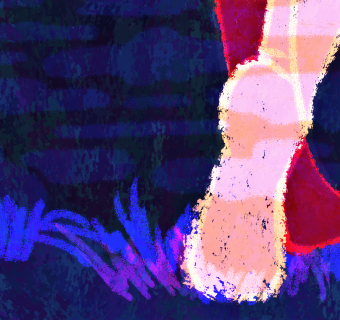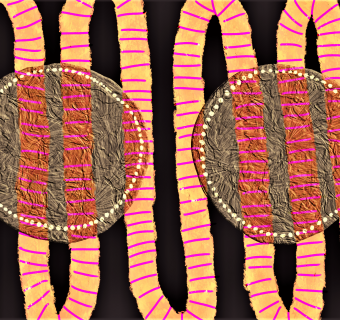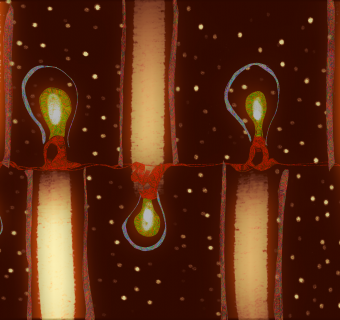The vaginal dilators I had ordered, per the instructions of my physical therapist, arrived at my apartment in a perfectly normal-looking box, as if they weren’t sold by adamandeve.com, a site that has my eternal gratefulness for coming up as “unspecified merchant” on my bank account statement. I kept them under my bed for two weeks, a reincarnated childhood monster that I waited to go away until I couldn’t stand the guilt of leaving sixty dollars’ worth of a medical device under my bed. I opened the box for the first time.
They were very brightly colored— too bright. I’m supposed to contend with the smallest dilator first, no thicker than an index finger, canary yellow, smooth silicone. They progress through several size iterations until their final form, a hot pink, sturdy-looking one.
Sure those aren’t dildos? a friend asks.
My physical therapist’s instructions cleared that up:
Lay down
Relax
Breathe deeply several times
Relax!!
Gently insert to a pain level of 3/10; once comfortable, move further
Do not do for more than 10 minutes at a time
Repeat twice a day
So I put a towel down on my floor— I liked the way the wood felt cool against my back— and lay down. I took a lot of deep breaths. Then I decided not to start after all.
As bizarre as my newly prescribed floor ritual felt, it was infinitely better than the last experience I had contemplating my vagina on the floor a year earlier: lying naked in the fetal position and sobbing. I had just tried and failed to have sex with my then-partner. It was not the first time I had failed to have sex, but the first time I had to stop because I couldn’t take the pain. My vagina was broken, as I eloquently put it to my concerned partner. And no one seemed to see it but me.
There’s a long history of under-diagnosis of invisible pain, particularly for women. By the 19th century, Western medicine had slightly evolved beyond Aristotle’s normative medical pronouncement that “the female is, as it were, a mutilated male.” But women were still considered to be frail and feeble, their minds more susceptible to a certain brand psychological distress (this is what Freud defined as “penis envy”). For hundreds of years, a common disease in Western medicine was hysteria, a “catchall diagnosis” for women suffering from then-unknown physical conditions. Often the symptoms were ordinary expressions of female sexuality.
This gender bias is still present in modern medicine, and it is especially prevalent in pain management. Women are more often perceived as “anxious” rather than “in pain” and are significantly more often undertreated and undermedicated. Women wait an average of 65 minutes to receive painkillers after presenting with severe abdominal pain in the ER; men wait an average of 49 minutes, and those missing minutes make a difference. Women are seven times more likely than men to be misdiagnosed and discharged in the middle of having a heart attack. Although studies show that women experience severe pain more often than men do— and have an easier time of expressing that thanks to other gender biases— they are still consistently taken less seriously when they seek help.
It turns out that there’s still a bit of Aristotle in us: we’re still fighting our strong cultural tendency to link the medical and the moral. In early Western medicine, it worked in a feedback loop; because women were biologically different than men and therefore medically inferior, their inner selves were lesser as well. That same language still defines women’s sexual choices, classed and racialized as well as gendered: slut, prude, whore, thot, skank (your parents’ generation), slag (British), and, of course, ho.
That all seems contrary to the world of Cosmopolitan and Glamour and Refinery29 that I grew up in, a world where Sex in the City was the model for young women’s idea of adulthood. We can thank feminism’s sex-positive movement for that— as well as for a robust discussion of porn from a women’s point of view, the idea that women can have sex like “men do” (emotionless, unattached) and men can have sex like “women do” (emotional, attached), and today’s assumption that women can and should seek out their own sexual pleasure. All of this was very helpful for a young girl who never uttered the word “sex” in front of her Catholic-raised parents and who would fall asleep during Virginia’s state-mandated abstinence-only health class.
One consequence of this cultural change, though, was the development of a popular discourse that made individual sexual freedom essential to a woman’s personal freedom. It was empowering to know that women could manifest their power and embrace their needs through their sexual desire and desirability. But I looked at the world around me and saw that badass women were always having sex whenever they wanted to have sex— and it was precisely that sexual behavior that made them so badass.
Plus, they always seemed to enjoy it.
This presents a problem when the sexual experiences you are having do not feel assertive or positive or pleasurable but straight-up painful. (I spent a year in high school believing that I must be asexual). When I first overcame my embarrassment, as a seventeen year old, to ask my pediatrician about sex, she kindly assured me that pain was normal for the first time. That I should always use enough lube, and only do what I was comfortable doing, and make sure that I was “warmed up” enough before trying any kind of penetration.
But what about pain during the second time? The third time? The fifth time? I certainly wanted to have sex. I was getting aroused fairly normally. But sex— not just penetration, but all kinds of sex— hurt. Really hurt. So every single time I would convince myself that this time would be better. Every single time when it invariably wasn’t, I would count one-two-three-four one-two-three-four in my head, trying to wait out the pain, trying to remember to breathe, trying to still participate the way I wanted to. As I got older, my more experienced partners began commenting on how “sensitive” I was. My body had started to flinch and tense when anything came close to my genitals.
I played off my gasps of pain as gasps of pleasure.
I went to a doctor. “Are you sure you’re using enough lube?”
I went to a gynecologist. “It’s really important that you’re relaxed during the process. It’s all mental.”
Back to the doctor. (I was racking up the copays). “Do you use lubricant?”
“It’s really just in your head.”
“Make sure you’re using plenty of lubricant.”
I had started getting a recurring tear in the tissue at the opening of my vagina. It would sometimes bleed when I put in a tampon. I stopped riding my bike because it would make me sore for days.
“Sex sometimes just takes a while to get used to.”
“Are you completely relaxed?”
I was treated for a yeast infection, and then treated again. A different gynecologist noticed my sensitivity, suspected it was a kind of contact dermatitis, or skin irritation. She took a biopsy to make sure something weird wasn’t happening. I stopped using scented soap and non-cotton underwear and tried to wear leggings less. She guessed, probably correctly, that I had low estrogen— making my vulvar tissue sensitive and delicate. She gave me an estrogen cream for the area, but it did not help.
The pain seemed to be getting worse and worse. Or, more likely, I was feeling more pain because I had started expecting it, my whole body unconsciously tensing in fear.
Well, this is it, I thought. I was never going to know if this thing was real or all in my head, I was never going to be cured, and I would have to explain an apparently nonexistent condition to every potential partner, every person that I couldn’t give one of my excuses to twice in a row— “I’m on my period.”
“I’m too tired.” Sometimes I would choose pain over the embarrassment of admitting pain.
I started planning for a new tattoo: below my navel, an arrow pointing downward, a sign that said “closed for business.”
That was the extent of the language I had to explain the pain I felt. “It’s broken,” the classic, began to be supplemented by phrases that referred, not to my vagina, but to me. In a drunken, teary state, I told my best friend that “I wasn’t a real woman.” I was “messed up,” “wrong,” a “fake girl.”
Three years. It was three years until I was given the language to understand my own pain. Every doctor’s visit was tortuous, painful, hopeless. There’s a specific kind of vulnerability that comes from covering your private parts with a tiny sheet, bare butt on the parchment paper cover of a doctor’s table.
Everything seemed the same the day I was diagnosed. I was a reluctant and angry patient. I was asked if I was relaxing, using lube, avoiding skin irritants. When I laid down and put my feet in the stirrups I was already bracing myself for the freezing pain of the speculum— but the gynecologist produced a single q-tip, told me to tell her what I was feeling, and started to gently press the q-tip around my vulva and inside my vagina.
And there it was, the invisible pain, the pain that I suddenly realized had been so difficult to describe because it was completely unlike any pain I had felt before: a stinging, itchy burning in some places; a low, deep throb in others, sometimes both at once. I tried to be stoic and not gasp and breathe through my nose and waited. You, the gynecologist said, emerging from between my legs, have vulvodynia.
Let’s break that down.
vulvo= vulva
vestibul= literally a porch, an entryway
dynia= pain
itis= inflammation
Translation: the vulva and interior walls of the vagina hurt and get irritated when touched. More specifically, I have a kind of vulvodynia that happens with contact, sometimes known as vulvar vestibulitis or provoked vulvodynia.
My vagina is a muscle. This is a fact I had literally never considered before getting diagnosed. It’s situated in what my physical therapist describes as a “bowl” of muscles, including ones from your butt, your very lower abdomen, and your hips. This is called the pelvic floor. Everyone has a pelvic floor. Among other things, it’s how you control when you pee. So if your hips are tight and your butt is tight and and your lower abdomen, like mine, has actual knots in it— those seemingly separate parts can all make a difference when it comes to your vagina.
This was confirmed when I first when to physical therapy, one of the most common, and likely most effective, treatments for pelvic floor dysfunction. I got to see my pelvic muscles in action for the first time when my physical therapist hooked me up to a biofeedback machine. It looks like a Geiger counter that gave birth to a bunch of little wires with flat circular sensors at the end. The sensors, which my therapist stuck all around my hips and butt, pick up electric activity from from my muscles and send it to the Geiger counter-looking thing. I get a visual representation of muscle “flex.”
My goal was seemingly simple: to fully relax my pelvic floor. The biofeedback monitor had a number and color scale. Red=bad. Green=good. Green=relaxed muscles. I watched the lines on the monitor flicker in between red and orange. It seemed to take an inordinate amount of concentration just to breathe in and out slowly, expanding and contracting my lower belly as I had been instructed. I spent what felt like hours trying various methods of relaxing my pelvic floor that seemed to solely exist in my imagination. All I needed to do was get to the green. And I could not do it.
I did not know— my body did not remember, as my physical therapist explained it— how to relax my pelvic floor. (If you’re familiar with Kegel exercises, it’s like walking around doing the “clench” part for however many years straight). The problem was a word that I had only heard once before in my life. Vulvodynia.
Pro tip: you haven’t had a truly good massage until your friend/partner/masseuse finds that one point that sparks pain in a seemingly unrelated part, like a spot on your neck that you can also feel in your shoulder blade. Those points are colloquially called “trigger points,” and they feel like a ball of tensed-up muscles. They’re so tense that they can spark pain somewhere else in your very interconnected muscular system. Why do I know this? Well, I’ve had a vagina massage, of course!
A “massage” is a simplistic way to put it, but it’s basically why pressing a q-tip around my vulva could be used to diagnose me. A gentle q-tip or finger should not hurt, but if you have vulvodynia, it’s quite painful. And, when you hit a trigger point in your vulvar tissue or vaginal muscle— that kind of pain is extraordinary. It feels wrong, alien; it robs you of your breath; it burns, at first, then it pulls a deep, hot ache from inside of you, radiating through your pelvis and hips and stomach and butt. One-two-ow-ow-three-ow-ow-breathe!-one-two-ow-relax!-one-two-ow-ow.
As much as it hurt, though, I was validated, a little triumphant. For all the pain and discomfort in massage and physical therapy and dilators, it was different. This time, finally, I had an explanation.
Well, sort of.
The truth is that vulvodynia remains understudied, probably underestimated, and very difficult to diagnose. Almost no controlled trials have been performed to test the results of different treatments.
There is likely a huge psychosomatic component to the condition that has barely been researched.
No single cause has been identified for vulvar pain, so prevention is impossible, and the multi-sided disorder is notoriously difficult to explain to both patients and doctors.
In a 2012 study, half of the women who met the screening criteria for vulvodynia had sought medical help. Only 1% of those women were diagnosed with vulvodynia.
Even if a healthcare provider actually knows what vulvodynia is (or how to diagnose it), they are often at a loss for how to treat it. According to a 2014 study in The International Journal of Women’s Health, despite the fact that vulvodynia presents “significant burden” to both society and individuals, “standard evidence-based practice guidelines do not exist for the management of vulvodynia.” This is partially because research on chronic pain in women is extraordinarily limited and underfunded. It’s also because pelvic pain in particular is highly variable and individualized.
Although my vulvar pain was quickly identified as primarily stemming from pelvic muscle dysfunction, low estrogen levels and a high concentration of nerve endings in my vulvar tissue are two likely candidates as well. It’s unclear what came first; I will never know if the pain preempted my muscular issues or if my pain resulted from those muscular issues.
I thought I had an answer. I thought I had a cure. But all the diagnosis did was leave me with more questions. I left my first session of physical therapy feeling worse, not better. It could take years for me to see a reduction in the pain— if I even saw a reduction in the pain— years of stretching and attending yoga and using dilators and checking in on my breathing regularly. I resented getting help because all it meant was that I wasn’t “fixed” yet. I refused to do my exercises and avoided the dilator because I didn’t want to admit to the pain, knowing that every day I pretended to be fine I was pushing my recovery further and further away.
I was— sometimes still am— bitter. My friends weren’t stretching their hips several times a day just to have sex. My friends weren’t getting up every thirty minutes of sitting to make sure their muscles hadn’t gotten tense just to have sex. My friends weren’t late to parties because they had forgotten to gently stick a brightly-colored silicone finger into their vagina, they weren’t going to physical therapy every single week, they didn’t have to care if they breathed “right,” they didn’t have a phone alarm that reminded them to relax at various points in the day, they weren’t advised to go to yoga several times a week and avoid biking and running just to have sex.
Even though I knew what it was, I still had to explain something ridiculous and vague to partners, potential partners, the occasional close friend— and what could they say about it? Sorry? I tended not to be descriptive; if I used the actual word “vulvodynia,” I was usually asked to repeat it a few times. I couldn’t blame them. I didn’t have a response to vulvodynia either. It seems a little obvious: if it would help so much to relax my muscles, then why don’t I just relax?
Vulvodynia is not “all in my head,” but my head has a lot to do with it. That’s one of the reasons I practiced with a dilator: I needed to retrain my brain to feel safe during penetration. If I’m expecting or anticipating pain my body goes into physiological distress mode— shallow breathing, tensed muscles, nerve receptors on high alert— and my pelvic floor is, if possible, even more tense than it was before.
I can’t seem to escape the possibility, then, that I’m a fake or a fraud. And that’s what I feel like when I flirt with someone, or let them know I want to be physically intimate— as if I’m misleading them. I imagine walking around at parties or bars with a flashing sign above my head:
Warning. Vagina unavailable for undisclosed period. Still interested. Accepting pity donations.
It felt like I couldn’t participate in what seems like an essential part of college culture, every book and movie and tv show about the human condition: finding someone you like and can sleep with regularly.
I was searching the world, desperately, and saw nothing and no one like me reflected back.
This is not true, of course. The world does not end if you can’t participate in sex the way you might want to. There are lots of women with vulvodynia and a whole host of other pelvic floor disorders. In the grand scale of things, I have it easy. I’m young enough to still be covered by my parents’ insurance. I’m young enough that a diagnosis didn’t mean there were decades of suffering before it, young enough that I wasn’t completely overwhelmed by a sudden shift in my conception of my womanhood. For women who are married or who have a long-term partner, getting diagnosed with vulvodynia can be a devastating blow to their sex life. Many women don’t live anywhere near a massage therapist that is familiar with the pelvic floor. In a lot of ways I’m lucky.
I’m also lucky in the sense that vulvodynia forced me to understand my own body. I would not have taken the time to appreciate what I do have, to listen to the signals my body gives me, to explore what might feel okay. Have you ever stared at your vagina in one of those magnifying makeup mirrors? No? Well, you should consider it. It’s initially terrifying, yes, but eventually you’ll become more comfortable with staring down your own genitals. I mean, people with penises have that part easy. Vaginas have all these folds, and also, they face the ground. It makes it pretty hard to get to know one another; I know mine like the back of my hand.
There’s not a real end to my story. Once I graduate and move to a new city, I’ll have to restart my treatment plan. I’ll have to find doctors who understand pelvic pain and will take mine seriously. I’ll have to navigate dating in my twenties with invisible pain. It will be hard, and it will be lonely, but now, at least, I will understand my pain. I know that it is possible to find partners who understand, try to understand, what vulvodynia means for me. I know that I can keep pushing through. I know that this isn’t the end of the world, or the totality of myself, or a representation of my womanhood. I know that I’m not alone.
And I know that I won’t stop imagining that one day, someday, I’ll wake up and be completely pain free.
By Isabella Ciambotti

Isabella Ciambotti is a fourth-year in UVA's Area Program in Literary Prose. She enjoys writing, eating and accumulating books. She thinks she is very funny.







